You can have all the skill in the world, but if you want to make it big on YouTube, you’ll need one of the best vlogging cameras.
Virtually any camera may be a useful tool for vlogging, and many of the top camera phones can also do a good job. Nevertheless, if you want to take your YouTube, Instagram, or TikTok profession to the next level, you’ll need equipment specifically suited for the task.
That’s exactly what you’ll get with our picks: image stabilization for super-smooth film, flip-out screens that make it easier to shoot oneself, color-grading and other advanced video tools, or increased audio-capture skills. Of course, all of these cameras can capture still images if necessary.
The Sony ZV-1 – a camera specifically intended for internet content creation — is our pick for the best vlogging camera for vloging and taking pictures for most people. It offers an impressive set of specifications, including a built-in Zeiss lens, a forward-facing screen, and Sony’s famous autofocus.
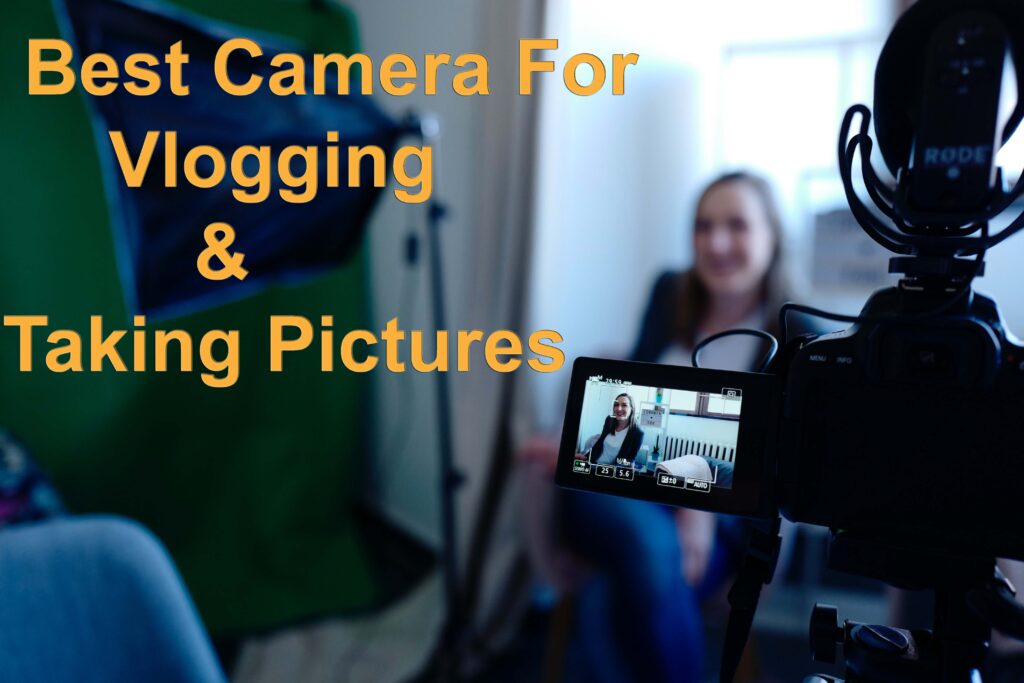
Photo by CoWomen: https://www.pexels.com/photo/black-video-camera-2041396/
In today’s digital era, capturing and sharing our experiences through vlogging and photography on youtube or any platform has become more popular than ever. Whether you’re a seasoned are expert content creator or an enthusiast looking to document your adventures, having the right camera can make all the difference. With numerous options available on the market, it’s essential to choose a camera that perfect in both vlogging and photography.
The best camera for vlogging and taking pictures should combine excellent video capabilities with high-quality image capture. It needs to be versatile, portable, and user-friendly, allowing you to effortlessly switch between shooting videos and capturing stunning photos. Furthermore, features such as built-in stabilization, autofocus, and exceptional low-light performance can significantly improve your movie and photographs, resulting in professional-looking results.
having a camera with advanced networking options, such as Wi-Fi or Bluetooth, can make transferring files to your devices or instantly uploading them to social media platforms much easier. This feature offers real-time engagement with your audience and seamless content exchange.
Considering factors like resolution, sensor size, lens options, and overall durability is also crucial when selecting the best camera for vlogging and photography.
These variables help the camera create clear, detailed photos and videos in a variety of lighting settings.
Finally, the ideal camera for vlogging and photography is subjective, as it is determined by your unique demands, preferences, and budget.
However, by researching and comparing different models, you can find the ideal camera that suits your creative vision and elevates your content creation to new heights.
- Best Compact Vlogging Camera: Sony ZV-1
- Best Compact Mirrorless Vlogging Camera: Canon EOS R50
- Best Value Full-Frame Vlogging Camera: Canon EOS R8
- Best Vlogging Camera Overall: Sony ZV-1F
- Best Action Vlogging Camera: GoPro Hero 11 Black Creator Edition
- Best 360-Degree Vlogging Camera: Insta360 X3
- Best Vlogging Camera For YouTube: Panasonic Lumix GH6
- Best Budget Action Vlogging Camera: Akaso V50 Elite
- Best Vlogging Camera With Stabilization: DJI Pocket 2 Gimbal Camera
How I Picked the Best Cameras for Vloging and taking Picture
Each camera is unique, but the best ones have a few characteristics. This section is dedicated to revealing the criteria I used to determine the best vlogging cameras, so let’s get started:
Cost
The costs aren’t always indicative of the quality of the cameras, but they are an essential component that I considered. Given that the lowest model on the list costs less than $200 and the most expensive one costs over $7,000, it’s easy to see why price matters.
The entry-level cameras are the same price as any webcam, but the versions we’ve chosen offer significantly more variety and power. Needless to say, the most costly titles on the list cannot even be compared to their less expensive counterparts, as they dominate every performance metric except pricing.
To ensure that there is a great model for everyone, regardless of budget, 19 models from various price-point categories have been included on the list of the best vlogging cameras in 2023.
Versatility
A versatile vlogging camera can function in any environment, whether it’s raining, pitch black, or the sunniest day of the year. For traveling vloggers, the ability to adjust to different situations, particularly lighting-related constraints, is very vital.
Aside from that, we’ve taken special attention to selecting camera models that are waterproof, or at least water-resistant, so you may film or take photos near beaches or in severe rain.
When it comes to adaptability, zoom range, interchangeable lenses, and accessible effects all play vital roles. Certain models on the list meet all of the criteria, while others can only be utilized in very particular situations (extremely low light or excessively bright lighting, for example).
Standalone versus Camera Bundles
For the purposes of this evaluation, we have only chosen standalone cameras (camera bodies) rather than bundles.
Although it might be claimed that a high-quality bundle can include a cool accessory or two, it’s also safe to presume that most vloggers have at least a few of basic attachments.
Value bundles are sometimes exactly what they sound like: they add value by including a variety of accessory-related items (some of which are camera attachments, others may be tripods, straps, and such). Yet, every accessory included in these bundles is usually simple and flimsy. That’s why we didn’t recommend any bundles, instead leaving the accessory option totally up to you.
Multiple Connectivity Options
Even if you have one of the most powerful cameras on the market, it won’t be as useful if you don’t have adequate storage capacity for your photos and movies.
That’s why we chose cameras that work with a variety of MicroSD cards, Wi-Fi, and Bluetooth technology.
best vlogging camera for beginners
Sony ZV-1

The Sony ZV-1 is a small yet capable camera built for vloggers and video creators. It’s a game changer for anyone wishing to take high-quality film, thanks to its amazing video capabilities and user-friendly features.
The ZV-1 features a 1-inch 20.1-megapixel Exmor RS CMOS sensor, which provides excellent image quality and low-light performance. Even in difficult shooting settings, its rapid autofocus technology assures sharp and accurate focus.
The ZV-1’s dedicated 24-70mm f/1.8-2.8 lens is one of its notable characteristics. This adaptable lens has a wide variety of focal lengths, making it perfect for both wide-angle photos and close-up details. The wide aperture allows for gorgeous bokeh and outstanding low-light performance.
The ZV-1’s vlogger-friendly features set it apart from other cameras. It has a completely articulating LCD screen that opens out to the side, allowing you to frame oneself while recording. The built-in microphone produces high-quality audio, and a hot shoe allows you to connect an external microphone or other equipment.
Furthermore, the ZV-1 includes advanced video features including as 4K recording, high-speed slow-motion, and a variety of picture profiles for creative control over your movie. It also has a “Product Showcase” mode that swiftly shifts focus from your face to an object, making it ideal for product reviews or demonstrations.
In general, the Sony ZV-1 is an excellent camera for vloggers and content creators. In a small package, it combines superb image quality, user-friendly features, and amazing video capabilities. Whether you’re an experienced vlogger or just getting started, the ZV-1 is a worthwhile investment for creating professional-looking material.
best vlogging camera under $500 with flip screen

Max video resolution: 4K (at 30 fps) | Weight: 14.6 ounces | Live streaming capability: Yes | Still image resolution: 21 megapixels | Connectivity: USB-C, Wi-Fi, Bluetooth | Display size: 3-inch touchscreen
Best for: specialty shooting and greater creative control.
The Sony ZV-1F is a less expensive choice than the Sony ZV-1 or the Sony ZV-E10, both of which are built primarily for vloggers and content makers. It has a variety of user-friendly features, such as Product Showcase, smooth skin-tone effect, and one-touch backdrop defocus, to help you quickly create professional-quality content. Furthermore, thanks to the bundled three-capsule microphone and windshield, the ZV-1F is ultra-compact and can record clear sound with minimum background noise.
It contains a one-inch sensor and a fixed 20-millimeter wide-angle lens, which is ideal for capturing a natural perspective. The camera’s LCD rotates so you can frame your photographs, however it can be difficult to view in harsh sunlight. It can monitor the movement of your eyes and objects accurately, and it offers face auto-exposure with up to 4X digital zoom. Sony’s optional Bluetooth wireless shooting grip makes using this camera one-handed a breeze.
An excerpt from our complete Sony ZV-1F review: “Despite its newness, I believe this will swiftly become the go-to camera for high-profile vloggers, YouTubers, TikTokers, and social media influencers.” I realized that this model performs a good job of functioning as a standard point-and-shoot camera in addition to its primary vlogging role.”
best compact camera for low light video
Canon PowerShot G7X Mark III
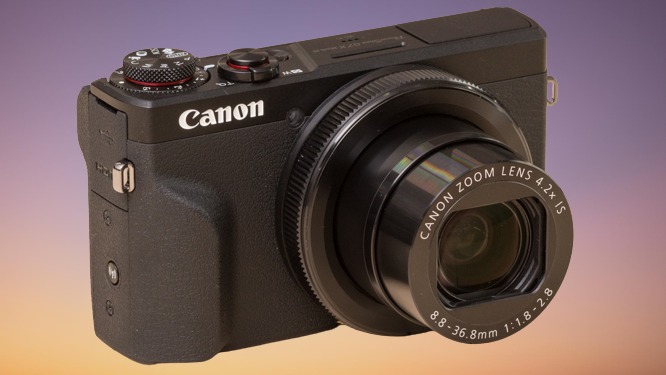
The Canon PowerShot G7X Mark III is a popular compact camera with advanced capabilities appropriate for both photographers and vloggers. The following are the Canon PowerShot G7X Mark III specifications:
- Image Sensor: 1.0-inch 20.1 megapixel CMOS sensor. This larger sensor size allows for better low-light performance and increased dynamic range.
- Image Processor: DIGIC 8 image processor. It offers faster image processing, better autofocus performance, and higher image quality.
3.Lens: The camera has an integrated zoom lens with the following specifications:
24-100mm focal length (35mm equivalent)
- Maximum Aperture: f/1.8-2.8
- Optical Zoom: 4.2x
- Image Stabilization: Optical Image Stabilizer (IS) to minimize camera shake.
- Autofocus: Dual Pixel CMOS AF with 143 autofocus points. It provides quick and accurate autofocus performance, making it appropriate for both still photography and video recording.
- ISO Range: ISO 125-12,800 (expandable up to ISO 25,600). The broad ISO range enables shooting in various lighting conditions while maintaining image quality.
- Shutter Speed: 30 seconds to 1/2000th of a second (mechanical shutter) and up to 1/25600th of a second (electric shutter) (electronic shutter). The electronic shutter allows for silent shooting and fast capture.
- Continuous Shooting: Up to approximately 20 frames per second (fps) in RAW burst mode and up to 30 fps in RAW burst mode with pre-shooting.
- Video Recording:
- Maximum Resolution: 4K UHD at 30 frames per second.
- Full HD: Up to 120 fps for slow-motion capture.
- Time-lapse Recording: Available.
- Built-in stereo microphone and 3.5mm microphone input for external microphones.
- LCD Screen: 3.0-inch, 180-degree tilting touchscreen LCD. It allows for easy framing and composition, especially for vlogging and selfies.
- Connectivity: Built-in Wi-Fi and Bluetooth for easy image transfer, remote control, and sharing capabilities.
- Battery: Rechargeable Lithium-ion battery (NB-13L). The battery life can vary depending on usage, but it provides approximately 265 shots per charge (CIPA standard).
- Measurements and Weight: The camera measures approximately 105.5 x 60.9 x 41.4 mm (4.15 x 2.40 x 1.63 in) and weighs approximately 304 grams (10.72 oz) when the battery and memory card are included.
These specifications should give you a good overview of the Canon PowerShot G7X Mark III’s capabilities and features.
READ ALSO: How To Start A Photography Side Hustle
Nikon Z30 With 16-50mm Lens
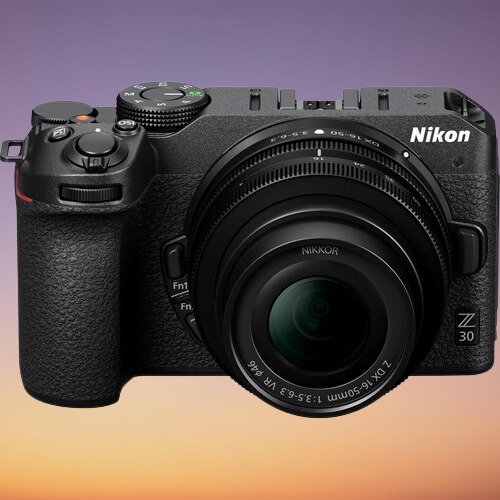
Max video resolution: 4K (at 30 fps) | Weight: 14.3 ounces | Still image resolution: 20.9 megapixels | Live streaming capability: Yes | Connectivity: USB-C, micro-HDMI, Wi-Fi, Bluetooth | Display size: 3-inch touchscreen
Best for: Vlogging, live-streaming or using as a general purpose camera.
The Nikon Z30 uses an APS-C CMOS sensor to shoot still photographs at 20.9 megapixels or 4K video at up to 30 frames per second. The Z30 is a mirrorless camera that is ideal for vloggers and live streamers. It’s worth noting that this model can record video for up to 2 hours and 11 minutes at a time, which is much longer than many competitors.
The camera incorporates a 3-inch, angle-adjustable touchscreen that may be oriented forwards, backwards, or at an angle. It contains an inbuilt microphone that can capture stereo sound and a 3.5 mm audio connection for connecting an external microphone but not a headphone. Nikon’s digital vibration reduction technology is used in the Z30 to decrease wobbles and shaking during filming (referred to as e-VR image stabilization). You also get 209 focusing points and quick autofocus with face and eye tracking that detects humans, dogs, and cats. For people who are new to photography, the “?” button provides easy explanations of all camera settings. If you already own Nikon DX lenses, you can get the camera body only. The camera body has enough weather sealing to protect it from light water and dust exposure.
Best Compact Mirrorless Vlogging Camera
Canon EOS R50 With 15-45mm Lens
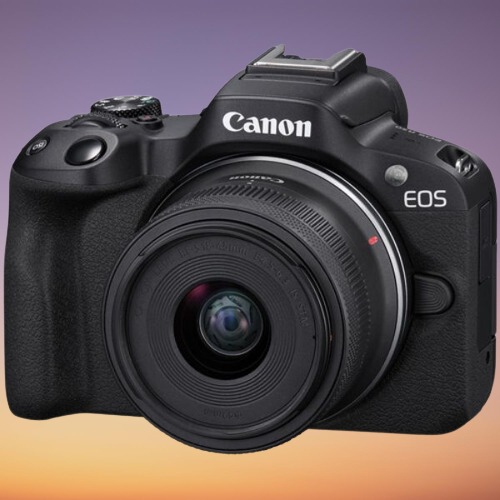
Max video resolution: 4K (at 30 fps) | Still Weight: 13.2 ounces | image resolution: 24.2 megapixels | Live streaming capability: Yes | Connectivity: USB-C, micro-HDMI, Wi-Fi, Bluetooth, 3.5 mm audio port | Display size: 3-inch touchscreen
Best for: Creating content with the option of having interchangeable lenses.
The tiny Canon EOS R50 mirrorless camera is compatible with Canon’s mirrorless RF-S lenses. The R50 shoots 24.2-megapixel still pictures and 4K video at 30 frames per second. The Digic X picture processor and dual pixel CMOS AF II autofocus system power this flexible camera’s 651 focus points. It offers a close-up demo mode, which is a must-have tool for content makers, in addition to a vertical movie mode, which is perfect for collecting video for TikToks.
The camera is lighter and smaller than the Canon EOS M50 Mark II, which employs Canon’s EF-M lens mount. The R50 is capable of recording up to one hour of video in a variety of lighting settings. A 2.34 million dot electronic viewfinder and a vari-angle touchscreen LCD provide you more shooting options than rival competitors. Canon’s Advanced A+ Assist feature automatically adjusts the camera settings for you, ensuring that you always get the finest shot. The R50 can be purchased with the RF-S 15-45mm f/4.5-6.3 IS STM lens (as shown below), or the body can be purchased separately for use with other Canon lenses (an optional adapter lets you use this camera with EF-mount lenses, too). The R50 lacks the weather sealing of Canon’s more expensive EOS R8, as well as image stabilization.
Sony Alpha ZV-E10 With 16-50mm Lens

Max video resolution: 4K (at 24 fps) | Weight: 12.8 ounces | Still image resolution: 24.2 megapixels | Live streaming capability: Yes | Connectivity: Wi-Fi, Bluetooth, USB-C | Display size: 3.0-inch touchscreen
The Sony Alpha ZV-E10 is a full-featured, lightweight camera that is ideal for professional vloggers. The ZV-E10 includes various unique video conveniences, like the ability to swiftly blur a background while zooming in on a topic, automatically adjust exposure for your face, and Product Showcase (all features also found on the ZV-1F). This tiny mirrorless camera differs from its less expensive sister in that it has interchangeable lenses and a big APS-C picture sensor.
The camera incorporates an attachable windshield and a built-in three-capsule microphone to record clear audio and video. It can record 4K video at 24 frames per second and still photographs at 24.2 megapixels, both with automatic image stabilization. By connecting the camera to a computer or mobile device, you may also use the ZV-E10 for live streaming. It can shoot continuously for up to 80 minutes on a single charge.
“I enjoy the huge button on top for starting recording, and the dedicated button for switching between still image capture and recording modes,” a tech editor comments.
Canon EOS R8 With RF 24-50mm Lens
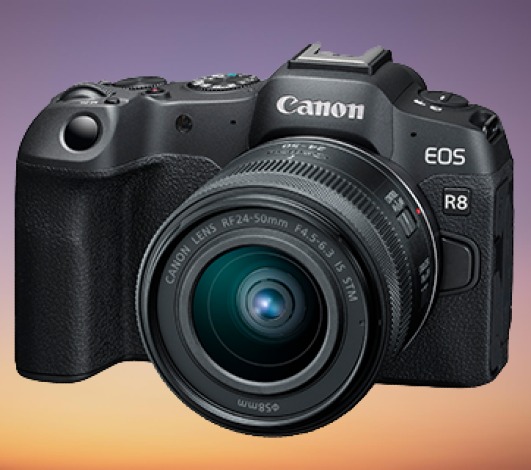
Max video resolution: 4K (at 60 fps) Weight: 16 ounces | | Still image resolution: 24.2 megapixels | Live streaming capability: Yes | Connectivity: USB-C, Wi-Fi, Bluetooth | Display size: 3-inch vari-angle touchscreen
The Canon EOS R8 is a lightweight full-frame camera with a lot of functionality. It weighs little more than one pound, making it slightly lighter than the Nikon Z5, Sony A7C, and Canon EOS R6 II. It can capture still photographs at 24.2 megapixels and 4K video at up to 60 frames per second. The video recording time restriction is two hours. The R8 not only has a ton of connections, but it also has Wi-Fi and Bluetooth. The camera’s 3-inch touchscreen display effortlessly turns to face forwards and backwards, making it a perfect choice for vlogging. The camera use the same sensor as the Canon EOS R6 Mark II. It has 1,053 autofocus points that cover the whole sensor area, and the dual pixel CMOS AF II system provides quick autofocus performance. The camera can shoot vertical video and can be used for live streaming or as a webcam for video calls.
This camera is simple to use, especially if you’re used to using Canon cameras. It also has a multi-function hot shoe built in. The topic detection for people, animals, automobiles, and landscape settings is accurate and extensive, and wireless content transfer to a mobile device is simple.
An excerpt from our complete Canon EOS R8 review: “The Canon EOS R8 is ideal for content creators and vloggers.” It combines diverse video recording capabilities with simple adjustments in a tiny, durable, and lightweight camera. The EOS R8’s viewfinder screen is simple to use.”
Best Budget Action Vlogging Camera
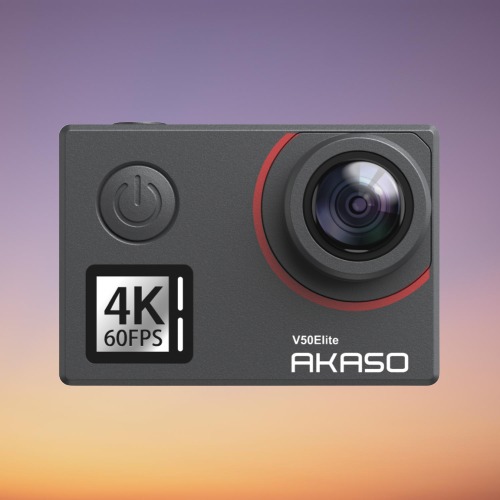
Max video resolution: 4K (at 60 fps) | Weight: 2.8 ounces | Still image resolution: 20 megapixels | Connectivity: USB-C, Wi-Fi | Display size: 2-inch touchscreen
While there are many similarities between the Akaso V50 Elite and the latest GoPro Hero cameras, affordability is not one of them. This camera costs roughly 75% less than the current GoPro, but it can shoot 4K (at 60 frames per second) video. It’s also waterproof (to 131 feet) and has an optical zoom of 8x. Among its other features are advanced image stabilization and the option to vary between a narrow, medium, and broad field of view. The camera comes with a slew of handy mounts and accessories—two batteries, a waterproof case, six mounts, and more—that would cost a fortune elsewhere.
The camera measures 2.4 x 1.6 x 1.2 inches and weighs about 2.8 ounces. The Akaso V50 Elite can be controlled via the camera’s back touchscreen and onboard buttons, voice commands, or a mobile app on your smartphone. If you need an action camera that is as versatile as a GoPro but not as expensive, this is the ideal choice.
IF YOU NEED BEST LENS FOR YOUR CAMERA YOU CAN VISIT BESTOFLENS.COM
FAQ About The Best Camera For Vlogging And Taking Pictures
Here’s a quick selection of some of your most common questions and our answers to help you get started with vlogging.
What type of camera do vloggers use?
Most successful vloggers invest in a high-end camera capable of producing intense video quality, such as mirrorless cameras. However, the optimum camera type for vlogging ultimately relies on the videographer’s use case.
Which camera is best for beginner vloggers?
As a newbie vlogger, you may not have the funds to purchase an expensive camera. Fortunately, there are less expensive options. Some good-quality, low-cost options for novices are the DJI Osmo Action 3, Panasonic Lumix FZ1000 II, DJI Osmo Pocket 2, GoPro Hero 11 Mini, Canon EOS M50 Mark II, and Sony ZV-1.
What camera do most vloggers use?
The majority of vloggers use high-quality cameras. These may be a little more pricey for beginners, but not all good cameras have to be expensive. Vloggers frequently employ cameras such as the DJI Osmo Action 3, GoPro Hero 11 Mini, Lumix S1H, and Canon EOS R5.
What is the best cheap camera for vlogging?
Some of the greatest blogging cameras for any price include the GoPro Hero 11 Mini, DJI Osmo Pocket 2, and DJI Osmo Action 3. Any of these possibilities will be a terrific addition to your activity if you’re just getting started.
Conclusion
Each year, when new cameras are released, it becomes easier (and less expensive) to find digital cameras capable of producing high-quality photographs and videos.
Remember, if you’re just starting out, stick to your budget since you’ll find something that suits your needs.
Once you’ve mastered your first vlogging camera, progress to something bigger and better on this list.
Have fun vlogging!
